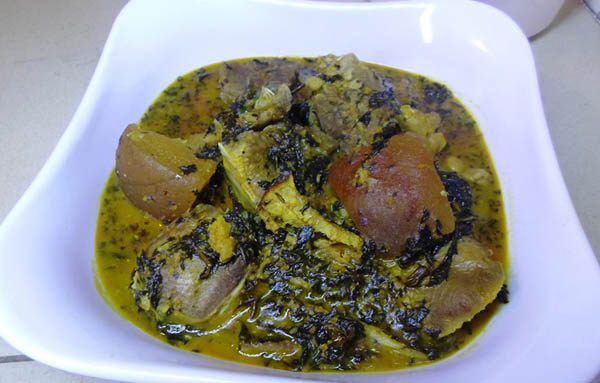The bitter leaf soup is one of the favorite soup types in Nigeria, especially among the Igbos. It is also known as ofe ede, because conventional preparation methods use cocoyam (ede) paste as a thickener, or ofe oha, when oha leaves, well known in Eastern Nigeria, are used instead of bitter leaves.
However, cooking the bitter leaf soup can be stressful if one has to cook the cocoyam corms till they get soft and pound them till no lumps are found. And who has time and stress to spare over a pot of soup when there is an alternative? Thanks to the inventiveness of Nigerians who live abroad, the bitter leaf soup can be made with oats- yes, processed oats available in convenience stores, in place of cocoyam. Here’s how to.
Ingredients:
Two cooking spoonfuls of oat
One wrap of ogiri (optional local seasoning prepared from fermented oil seeds)
Palm oil
Washed bitter leaves or oha leaves
Stock cubes, grounded pepper, grounded crayfish and salt to season
Meat: Assorted meat types for variety
Fish: Assorted dried fish/stock fish for variety
How to prepare:
- Grind the oats in a dry mill till they become powder.
- If you will use bitter leaves, probably already washed ones from the market, wash them again to make sure the bitter taste is reduced to a minimum.
- If you will use oha leaves, avoid cutting them with a knife so they don’t darken. Instead, shred them with your fingers.
- Season and boil meat and stock fish with stock cubes and pepper till they become tender.
- Add a cooking spoonful of palm oil or desired quantity for the size of your soup.
- Mix the oats with little water to a thick but running consistency.
- Gently add the oat mixture to the stock and stir till you get the desired thickness.
- Add the ogiri, if you have one, and crayfish.
- Cover the pot and allow to cook for about 10 minutes.
- Add (either of) the leaves and then allow to cook for 5 minutes.
- Add salt to taste, then cover the pot to simmer.
Soup is ready and can be served with garri, pounded yam, akpu or semolina.


